Page 92 of 592

8. If the child restraint has a top tether strap and theseating position has a top tether anchorage, connect
the tether strap to the anchorage and tighten the tether
strap. Refer to “Lower Anchors and Tethers for Chil-
dren (LATCH) Restraint System” for directions to
attach a tether anchor.
9. Test that the child restraint is installed tightly by pulling back and forth on the child seat at the belt
path. It should not move more than 1 inch (25.4 mm)
in any direction.
Any seat belt system will loosen with time, so check the
belt occasionally, and pull it tight if necessary.Installing A Child Restraint With A Cinching
Latch Plate (CINCH) — If Equipped
1. Place the child seat in the center of the seating position. For some second row seats, you may need to
recline the seat and / or raise the head restraint to get
a better fit.
2. Next, pull enough of the seat belt webbing from the retractor to pass it through the belt path of the child
restraint. Do not twist the belt webbing in the belt
path.
3. Slide the latch plate into the buckle until you hear a “click.”
4. Finally, pull up on any excess webbing to tighten the lap portion around the child restraint while you push
the child restraint rearward and downward into the
vehicle seat.
90 THINGS TO KNOW BEFORE STARTING YOUR VEHICLE
Page 93 of 592
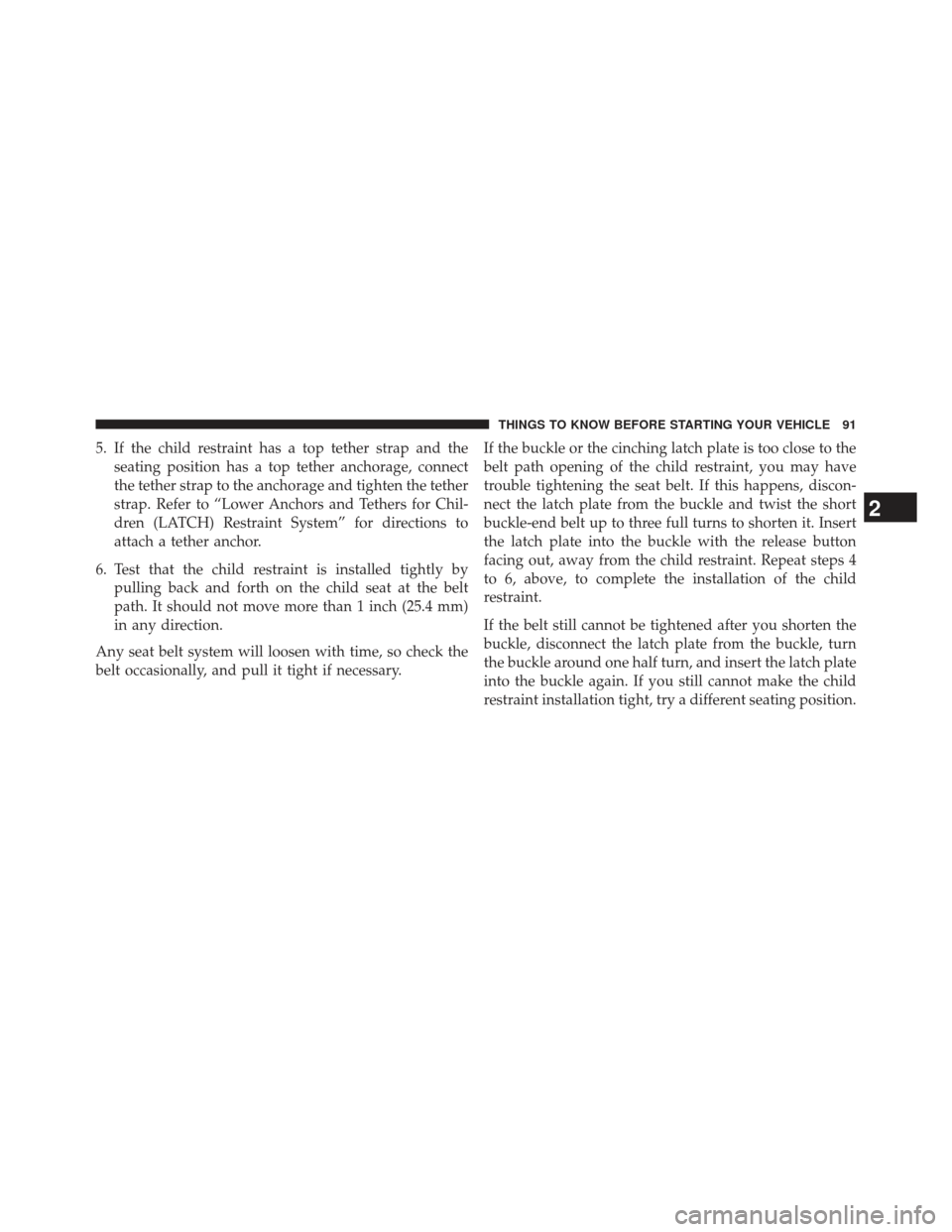
5. If the child restraint has a top tether strap and theseating position has a top tether anchorage, connect
the tether strap to the anchorage and tighten the tether
strap. Refer to “Lower Anchors and Tethers for Chil-
dren (LATCH) Restraint System” for directions to
attach a tether anchor.
6. Test that the child restraint is installed tightly by pulling back and forth on the child seat at the belt
path. It should not move more than 1 inch (25.4 mm)
in any direction.
Any seat belt system will loosen with time, so check the
belt occasionally, and pull it tight if necessary. If the buckle or the cinching latch plate is too close to the
belt path opening of the child restraint, you may have
trouble tightening the seat belt. If this happens, discon-
nect the latch plate from the buckle and twist the short
buckle-end belt up to three full turns to shorten it. Insert
the latch plate into the buckle with the release button
facing out, away from the child restraint. Repeat steps 4
to 6, above, to complete the installation of the child
restraint.
If the belt still cannot be tightened after you shorten the
buckle, disconnect the latch plate from the buckle, turn
the buckle around one half turn, and insert the latch plate
into the buckle again. If you still cannot make the child
restraint installation tight, try a different seating position.
2
THINGS TO KNOW BEFORE STARTING YOUR VEHICLE 91
Page 94 of 592
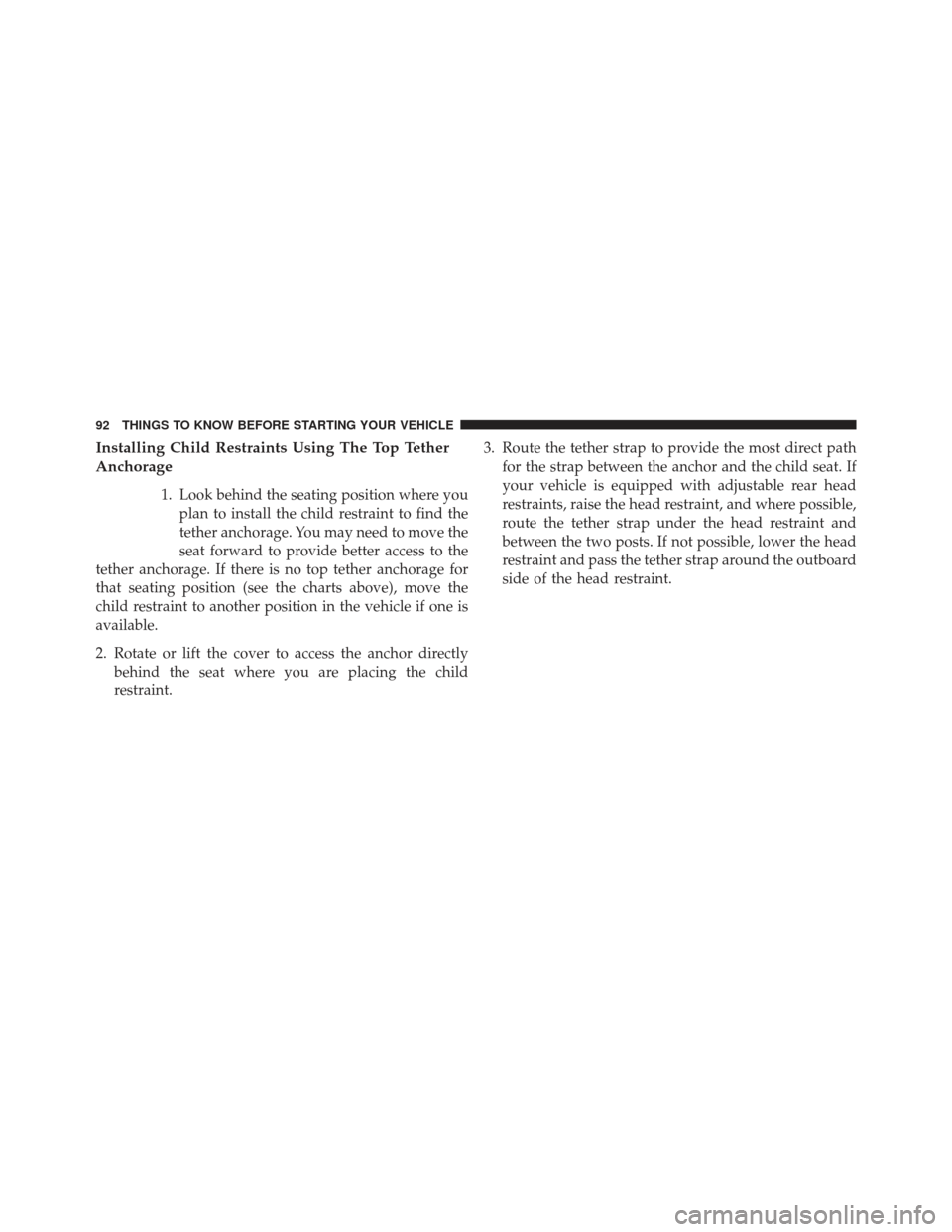
Installing Child Restraints Using The Top Tether
Anchorage
1. Look behind the seating position where youplan to install the child restraint to find the
tether anchorage. You may need to move the
seat forward to provide better access to the
tether anchorage. If there is no top tether anchorage for
that seating position (see the charts above), move the
child restraint to another position in the vehicle if one is
available.
2. Rotate or lift the cover to access the anchor directly behind the seat where you are placing the child
restraint. 3. Route the tether strap to provide the most direct path
for the strap between the anchor and the child seat. If
your vehicle is equipped with adjustable rear head
restraints, raise the head restraint, and where possible,
route the tether strap under the head restraint and
between the two posts. If not possible, lower the head
restraint and pass the tether strap around the outboard
side of the head restraint.
92 THINGS TO KNOW BEFORE STARTING YOUR VEHICLE
Page 96 of 592
1 — CoverA — Tether Strap Hook
3 — Attaching Strap B — Tether Anchor
4. Attach the tether strap hook of the child restraint to the top tether anchorage as shown in the diagram. 5. Remove slack in the tether strap according to the child
restraint manufacturer ’s instructions.
Transporting Pets
Air Bags deploying in the front seat could harm your pet.
An unrestrained pet will be thrown about and possibly
injured, or injure a passenger during panic braking or in
a collision.
Pets should be restrained in the rear seat in pet harnesses
or pet carriers that are secured by seat belts.
ENGINE BREAK-IN RECOMMENDATIONS
A long break-in period is not required for the engine and
drivetrain (transmission and axle) in your vehicle.
Drive moderately during the first 300 miles (500 km).
After the initial 60 miles (100 km), speeds up to 50 or
55 mph (80 or 90 km/h) are desirable.Tether Strap Mounting
94 THINGS TO KNOW BEFORE STARTING YOUR VEHICLE
Page 192 of 592

After releasing the seatback, it can be folded forward.
When the seatback is folded to the upright position, make
sure it is latched by strongly pulling on the top of the
seatback above the seat strap.WARNING!
•Be certain that the seatback is securely locked into
position. If the seatback is not securely locked into
position, the seat will not provide the proper sta-
bility for child seats and/or passengers. An improp-
erly latched seat could cause serious injury.
• The cargo area in the rear of the vehicle (with the
rear seatbacks in the locked-up or folded down
position) should not be used as a play area by
children when the vehicle is in motion. They could
be seriously injured in a collision. Children should
be seated and using the proper restraint system.
DRIVER MEMORY SEAT — IF EQUIPPED
This feature allows the driver to store up to two different
memory profiles for easy recall through a memory
switch. Each memory profile contains desired position
settings for the driver seat, side mirrors, adjustable
Folded Rear Seatback
190 UNDERSTANDING THE FEATURES OF YOUR VEHICLE
Page 292 of 592
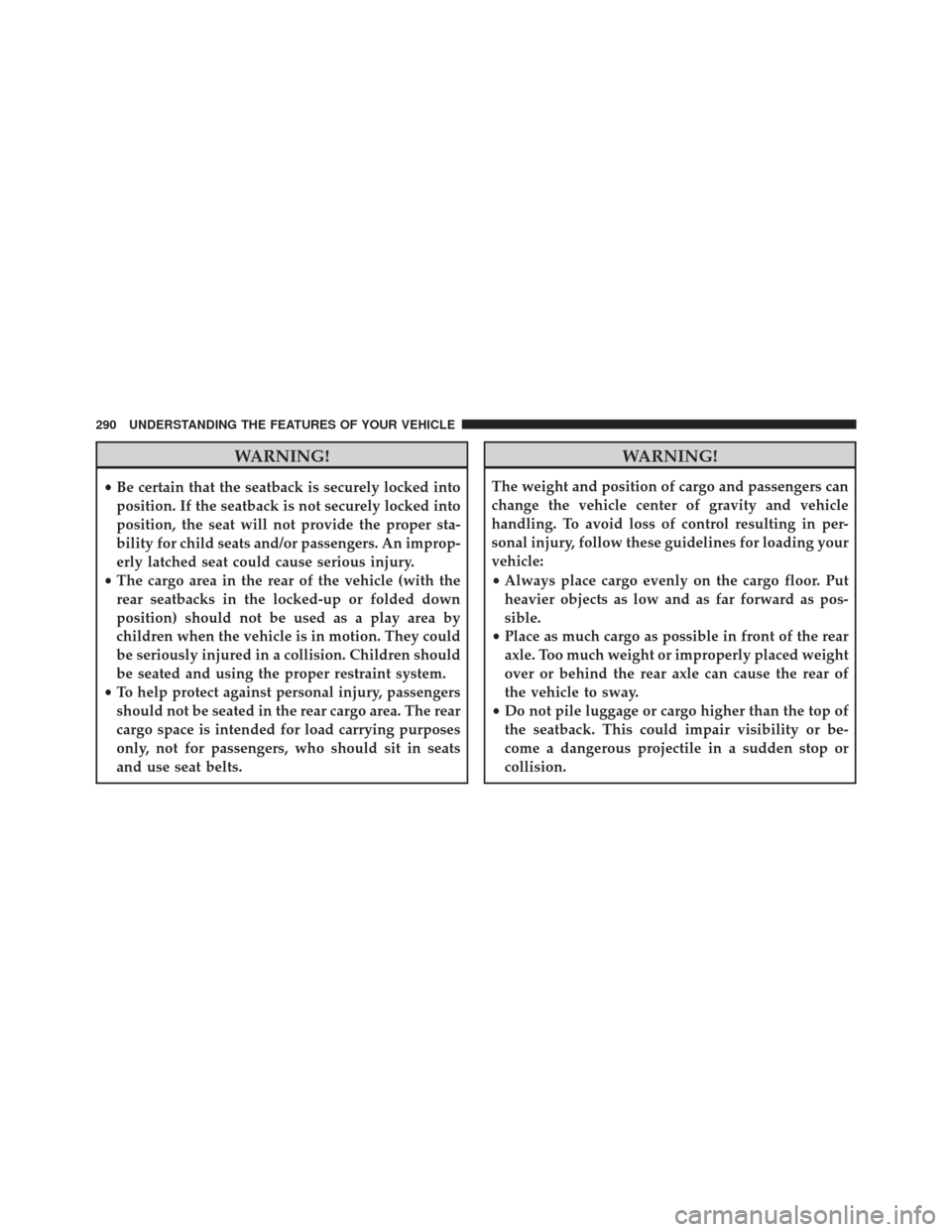
WARNING!
•Be certain that the seatback is securely locked into
position. If the seatback is not securely locked into
position, the seat will not provide the proper sta-
bility for child seats and/or passengers. An improp-
erly latched seat could cause serious injury.
• The cargo area in the rear of the vehicle (with the
rear seatbacks in the locked-up or folded down
position) should not be used as a play area by
children when the vehicle is in motion. They could
be seriously injured in a collision. Children should
be seated and using the proper restraint system.
• To help protect against personal injury, passengers
should not be seated in the rear cargo area. The rear
cargo space is intended for load carrying purposes
only, not for passengers, who should sit in seats
and use seat belts.
WARNING!
The weight and position of cargo and passengers can
change the vehicle center of gravity and vehicle
handling. To avoid loss of control resulting in per-
sonal injury, follow these guidelines for loading your
vehicle:
• Always place cargo evenly on the cargo floor. Put
heavier objects as low and as far forward as pos-
sible.
• Place as much cargo as possible in front of the rear
axle. Too much weight or improperly placed weight
over or behind the rear axle can cause the rear of
the vehicle to sway.
• Do not pile luggage or cargo higher than the top of
the seatback. This could impair visibility or be-
come a dangerous projectile in a sudden stop or
collision.
290 UNDERSTANDING THE FEATURES OF YOUR VEHICLE
Page 574 of 592
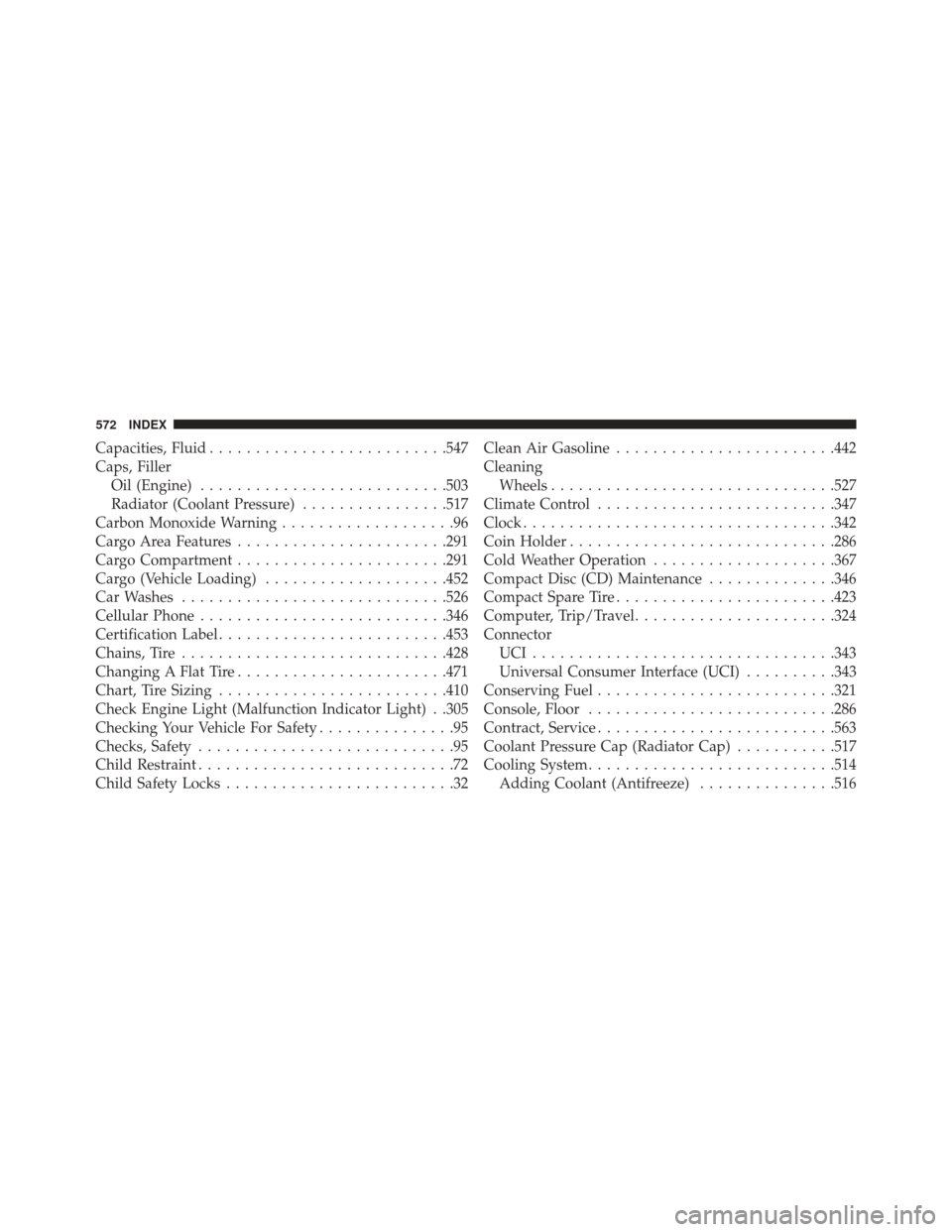
Capacities, Fluid......................... .547
Caps, Filler Oil (Engine) .......................... .503
Radiator (Coolant Pressure) ................517
Carbon Monoxide Warning ...................96
Cargo Area Features ...................... .291
Cargo Compartment ...................... .291
Cargo (Vehicle Loading) ....................452
Car Washes ............................ .526
Cellular Phone .......................... .346
Certification Label ........................ .453
Chains, Tire ............................ .428
Changing A Flat Tire ...................... .471
Chart, Tire Sizing ........................ .410
Check Engine Light (Malfunction Indicator Light) . .305
Checking Your Vehicle For Safety ...............95
Checks, Safety ............................95
Child Restraint ............................72
Child Safety Locks .........................32 Clean Air Gasoline
....................... .442
Cleaning Wheels .............................. .527
Climate Control ......................... .347
Clock ................................. .342
Coin Holder ............................ .286
Cold Weather Operation ....................367
Compact Disc (CD) Maintenance ..............346
Compact Spare Tire ....................... .423
Computer, Trip/Travel ..................... .324
Connector UCI................................ .343
Universal Consumer Interface (UCI) ..........343
Conserving Fuel ......................... .321
Console, Floor .......................... .286
Contract, Service ......................... .563
Coolant Pressure Cap (Radiator Cap) ...........517
Cooling System .......................... .514
Adding Coolant (Antifreeze) ...............516
572 INDEX
Page 585 of 592
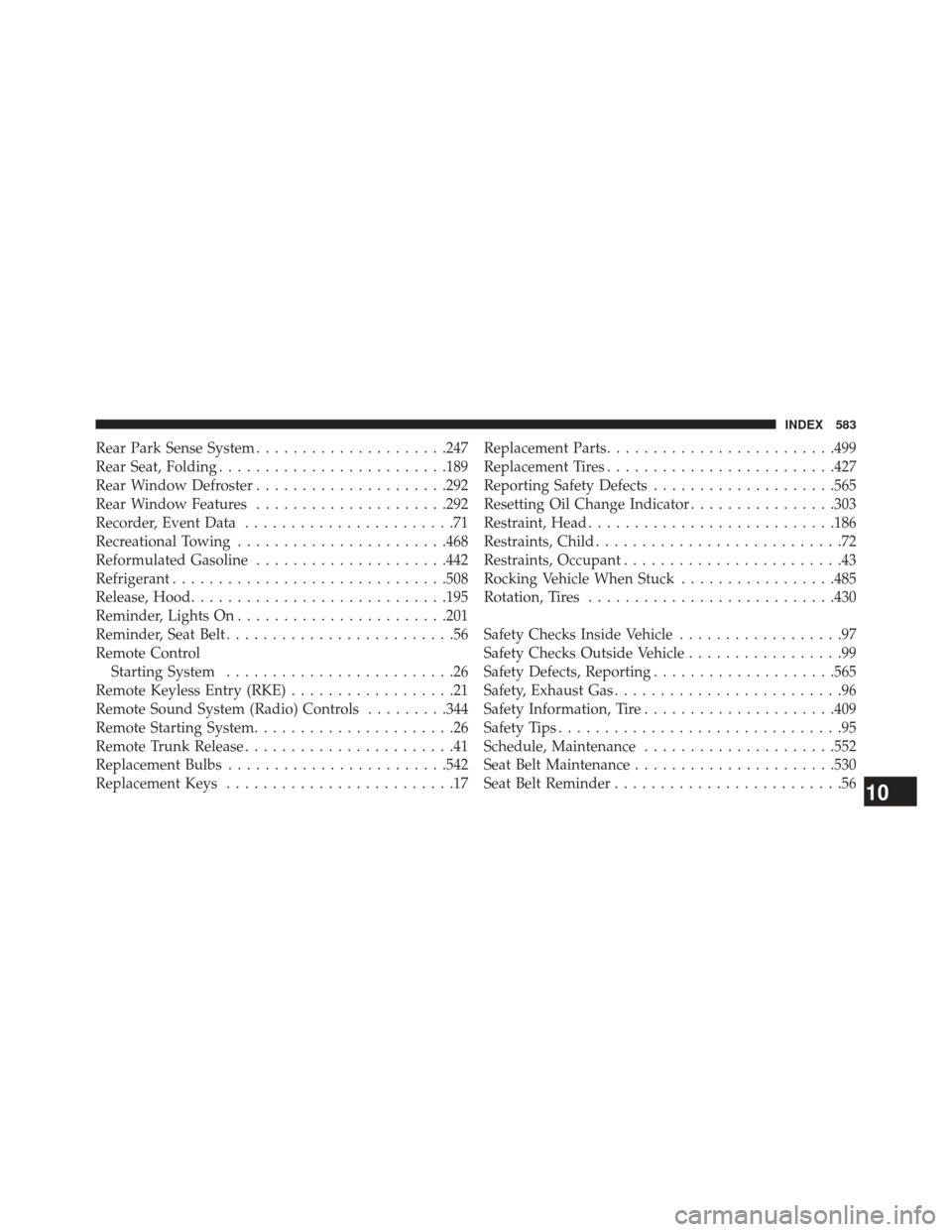
Rear Park Sense System.....................247
Rear Seat, Folding ........................ .189
Rear Window Defroster .....................292
Rear Window Features .....................292
Recorder, Event Data .......................71
Recreational Towing ...................... .468
Reformulated Gasoline .....................442
Refrigerant ............................. .508
Release, Hood ........................... .195
Reminder, Lights On ...................... .201
Reminder, Seat Belt .........................56
Remote Control Starting System .........................26
Remote Keyless Entry (RKE) ..................21
Remote Sound System (Radio) Controls .........344
Remote Starting System ......................26
Remote Trunk Release .......................41
Replacement Bulbs ....................... .542
Replacement Keys .........................17 Replacement Parts
........................ .499
Replacement Tires ........................ .427
Reporting Safety Defects ....................565
Resetting Oil Change Indicator ................303
Restraint, Head .......................... .186
Restraints, Child ...........................72
Restraints, Occupant ........................43
Rocking Vehicle When Stuck .................485
Rotation, Tires .......................... .430
Safety Checks Inside Vehicle ..................97
Safety Checks Outside Vehicle .................99
Safety Defects, Reporting ....................565
Safety, Exhaust Gas .........................96
Safety Information, Tire .....................409
Safety Tips ...............................95
Schedule, Maintenance .....................552
Seat Belt Maintenance ..................... .530
Seat Belt Reminder .........................56
10
INDEX 583